That’s a phrase every marketer dreads to hear. Without proper tools for organizing planning and workflows, content marketing becomes difficult to manage in a way that isn’t ad hoc.
Here at CoSchedule, we follow the philosophy of planning your work, then working your plan. For content creators, there’s no better organizational hub than a well-planned content calendar.
When your entire content marketing strategy is planned out on one calendar, it’s easier to keep organized, focus on deadlines, and be more productive. Not only that, but it keeps your entire team up to date with the latest and upcoming projects.
Just picture this:
- You have a versatile content calendar that can help you organize all of your campaigns, track your projects, and easily collaborate with your team.
- You’re provided with an easy-to-follow process for managing said calendar.
- You have several examples of what a great content calendar looks like.
Sounds too good to be true, right?
It’s not. In this post, we’ll show you how to build the perfect content calendar, keep it full with ideas, and make it easier for your marketing team to do their job.
[Tweet “The Best Content Calendar Template to Organize Your Entire Year via @CoSchedule”]
Table of Contents
- What is a Content Calendar?
- The Case for Using a Content Calendar
- Types of Content Calendars
- How to Set Up a Content Calendar
- How to Use a Content Calendar
- Advanced Content Calendar Tips
- Content Calendar Example
- A Content Calendar Case Study
Bonus: Grab Your Annual Content Calendar [Free Templates]
Before we show you how to organize content calendars, you’ll need the right tools in your arsenal. Get started with this trio of templates:
- Annual Content Calendar Template for effectively planning out your content all year long and keeping your team organized.
- Comprehensive Content Calendar Template that offers an alternative structure and layout.
- Basic Blog Calendar Template for managing a simple blogging schedule.
Snag your templates now, and then read on to learn how to use ’em.
[content_upgrade_shortcode]
What is a Content Calendar?
A content calendar can be anything used to plan, schedule, and organize content and other marketing projects.
Marketing teams rely on their content calendars to plan campaigns across different platforms—like the company’s blog and email marketing tool. It’s their right-hand for planning and creating a steady flow of high-quality content.

The Case for Using a Content Calendar
A content calendar is just another unnecessary marketing fad, right?
Not necessarily. “Winging it” doesn’t work with content marketing. If you don’t have a plan, you’ll end up wasting time you could be spending being productive.
That much is nearly guaranteed: if you don’t keep organized, you’ll be less likely to succeed.
A lack of planning leads to inefficiencies; things take much longer than they need to. In turn, you don’t have the results your leadership team is looking for. That increase in marketing budget you want will be 10x harder if you don’t know how it’ll be spent.
Using a content calendar makes it easier to plan out what you’ll be doing in the future. This could mean a week, a month, or however far ahead you’d like to plan ahead. You could even plan your content marketing efforts for an entire year, like we’ll show you in this post.
Just think about this: when you plan ahead for your future content, the likelihood of your content being significantly better is astronomical. This is because you have more time to research, draft, and add finishing touches to your final product.
Once you get your calendar built out, you’ll be able to:
- Hit deadlines more easily and hold yourself accountable for getting stuff done. Being able to visualize these deadlines on your content calendar makes this a walk in the park.
- See everything you’re working on in one place. Blog posts, social messages, events, email newsletters, podcasts, videos — whatever you’re busy creating.
- Think strategically about the content you’ll create. For example, instead of scrambling at the last minute to create content around a major holiday, you can plan for it ahead of time.
Your team will also be able to quickly see what everyone else is working on and when — making collaboration simple.
Types of Content Calendars
Now we know what a marketing calendar is (and why you should be using one for your content), let’s take a look at three different ways to plan upcoming content.
Spreadsheets
The simplest way to create a content calendar is to use a spreadsheet.
Tools like Microsoft Excel and Google Sheets make spreadsheets a free and easy way to plan upcoming content. It’ll take a bit of design work, but once it’s set up, you see your calendar at a glance and monitor the progress of each piece of content.
Bear in mind that if you’re using spreadsheets to manage your content calendar, your automation options are limited. It’s almost impossible to trigger events—like new content being shared with your email list—based on a change to your spreadsheet calendar.
Kanban Boards
Kanban boards, which look like virtual whiteboards with mini post-its, can also be used to manage a content calendar.
They’re great for visually managing workflows, and are especially suited for agile teams. You can use tools like Trello or CoSchedule’s Idea Board to create columns for the status of a piece, the platform it’s on, or the week it’s being published to get an overview of your upcoming content. Just drag-and-drop the card to the right column.
Calendar Software
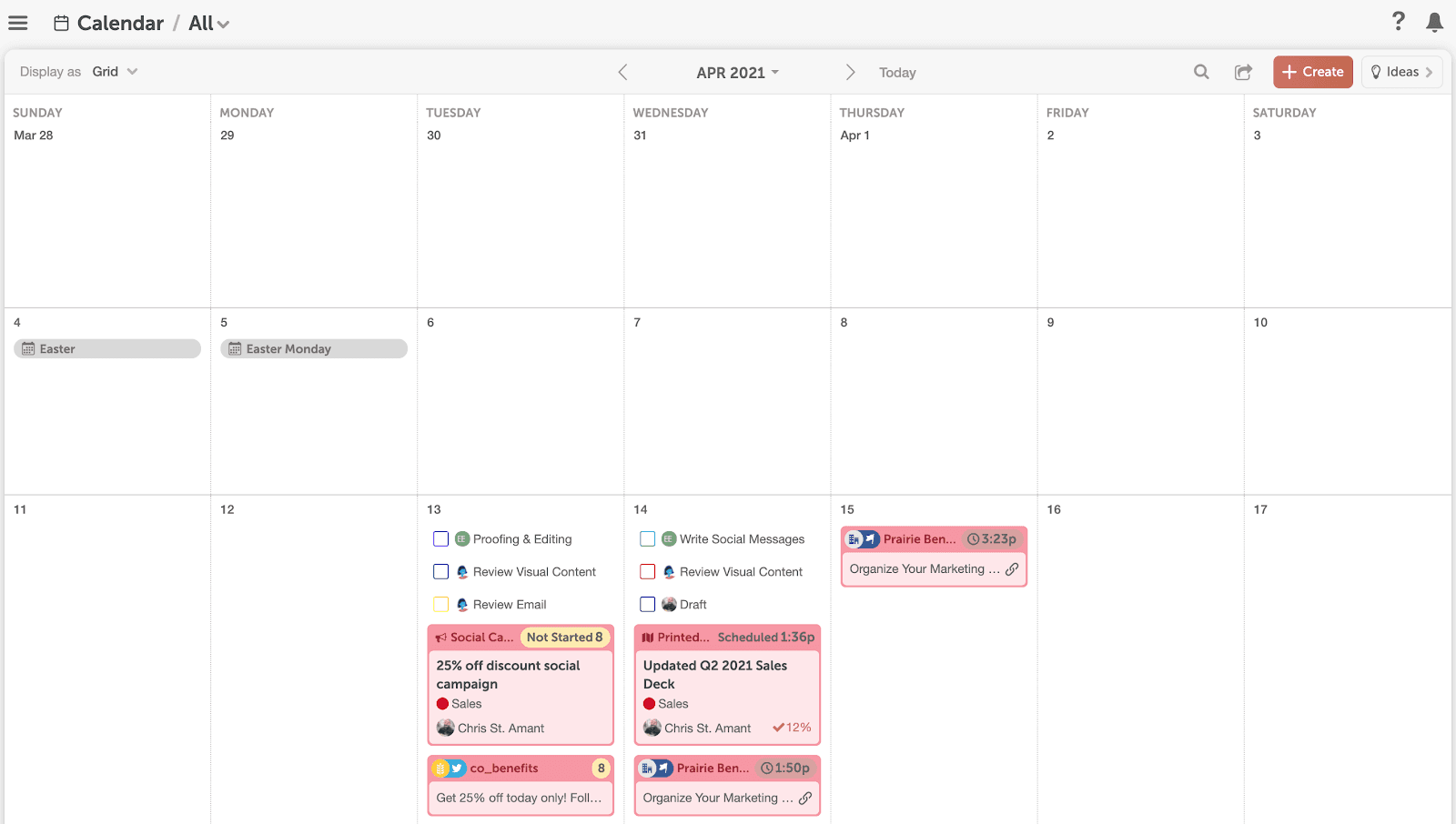
The best way to manage your content calendar is through marketing calendar software. (No, Google Calendar doesn’t count.)
We may be biased, but it’s for good reason. CoSchedule’s Marketing Calendar is the most powerful calendar on the market. The marketing team at CoSchedule uses our own software to organize every piece of our strategy.
You’ll be able to see important dates on your content calendar (such as product launches), and how that slots within your upcoming content.
Plus, CoSchedule integrates with other marketing tools you’re already using, including:
- Your CMS
- Social media platforms (including LinkedIn and Twitter)
- Your email marketing platform (MailChimp, ActiveCampaign, Campaign Monitor, and Constant Contact)
…to easily automate the distribution of each new piece. Talk about saving time.
How to Set Up a Content Calendar
Ready to make your own? Whether you’re choosing a simple spreadsheet or a marketing calendar, here’s how to set it up for success.
1. Determine Content Types
Before we get too much further, figure out which content channels and types you’re currently creating—and plan on creating—this year.
This could include:
- A blog or regularly updated website content. This is likely the bread and butter behind your content strategy. It’s also the type of content most often associated with content calendars and planning.
- Email. According to Campaign Monitor, it’s 40 times more effective than social media for customer acquisition.
- Podcasts. Speak to your audience through a recorded conversation in Spotify, Apple Podcasts, or Stitcher. Don’t know how to start one? We’ll show you.
- Webinars. Jump on a live video call with your audience and walk them through a solution to something they’re struggling with. (Bonus points if that ties in with your product/service offering.)
- Infographics. Nope, they’re not dead.
- Video. Video marketing is growing in importance, and you can use your calendar to plan every shoot.
- Print magazines, brochures, or newsletters. The print world is changing, but it’s not going away anytime soon.
- Anything else you’re working on. If it’s a marketing project, you can organize it on a calendar.
2. Choose Color-Coding
Next, decide on a color-coding scheme to quickly identify content on your calendar.
You can color-code your calendar any way you’d like. However, a successful scheme should incorporate the following elements:
- It should be agreed upon by everyone who will be using the calendar. Everyone should know which colors refer to which types of content.
- It should be consistent. If you decide Twitter messages are always highlighted in green and your graphic designer’s tasks are always in blue, it’s important to keep that straight. Otherwise, you can run into confusion and missed deadlines.
- It should be simple. Try to use only as many different colors as you need.
Here are a few different ideas for laying out color-coding schemes:
- By campaign. If you’re creating campaigns that span multiple channels, color-coding each piece of that campaign can make it easier to see when each piece will be published.
- By theme. Similar to color-coding by campaign, it can be helpful to see when different pieces of content are being published that belong to a theme or category.
- By team member. If certain team members have content or tasks they’re responsible for, color-coding by team members will help them see everything they need to get done, and when.
- By channel. If you’d prefer, you can also color-code content based on channel (for example: all Facebook posts in blue, all YouTube videos in red, all blog posts in orange, etc.).
If none of these ideas work, you can always come up with one of your own, too. Here’s what your calendar might look like once you’ve added some content to your color scheme:
Do This With CoSchedule: CoSchedule has built-in color coding functionality, called Custom Color Labels, to keep your scheme consistent.
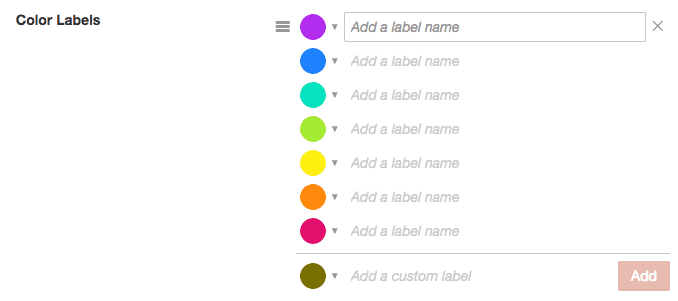
3. Make the Calendar Accessible Team-Wide
The final step in creating a content calendar is to give your entire marketing department access… even those who won’t be using it every day.
Making your calendar accessible team-wide gives everyone visibility. You won’t need the back-and-forth “what are we publishing next month?” questions. It’s all there on the calendar view.
Plus, stakeholders can see what you’re working on if they have access to the content calendar.
Getting buy-in (and bigger budgets) for the marketing department becomes much easier if stakeholders can see how their existing time and money is being spent.
How to Use a Content Calendar
Once you’ve got your calendar ready to go, let’s take a look at how you (and your team) can start using it.
Develop Content Ideas
Before you can fill your calendar, you’ll need ideas to plan around. You’ll need a lot of ideas, and you’ll need them fast, too. That’s where our simple brainstorming process comes in.
Here’s how it works in three parts:
- Spend ten minutes writing down every idea that pops into your head. Don’t worry if they’re good or not just yet. What’s important is getting your ideas down on paper.
- Spend another ten minutes scoring those ideas on a three-point scale. 3’s are great ideas that your target audience would want to read right now; 2’s need more refinement; and 1’s are duds. You’ll likely end up with more 1’s and 2’s than 3’s, but that’s okay.
- Spend ten more minutes choosing which of your 3’s you’ll create or implement. These are the best of your best ideas.
Alongside brainstorming, ask your team to do keyword research. This is an SEO practice that uncovers which phrases your target customers are already Googling. Find them, their search volume, and prioritize based on:
- How strong of a tie-in the keyword has with your product/service.
- The potential conversion value of ranking for the term.
- How difficult it would be to reach page one.
Add a day and time on your content calendar to run through this process once a month, and you’ll always have enough ideas to keep your content marketing machine moving forward.
After you have a solid idea of what your content is about and when you’ll be publishing it, you need to add those ideas to your content calendar.
In CoSchedule, you’ll find an Idea Board to organize your content backlog. It works similarly to your main content calendar, and helps you store content ideas before they’re added into your queue:
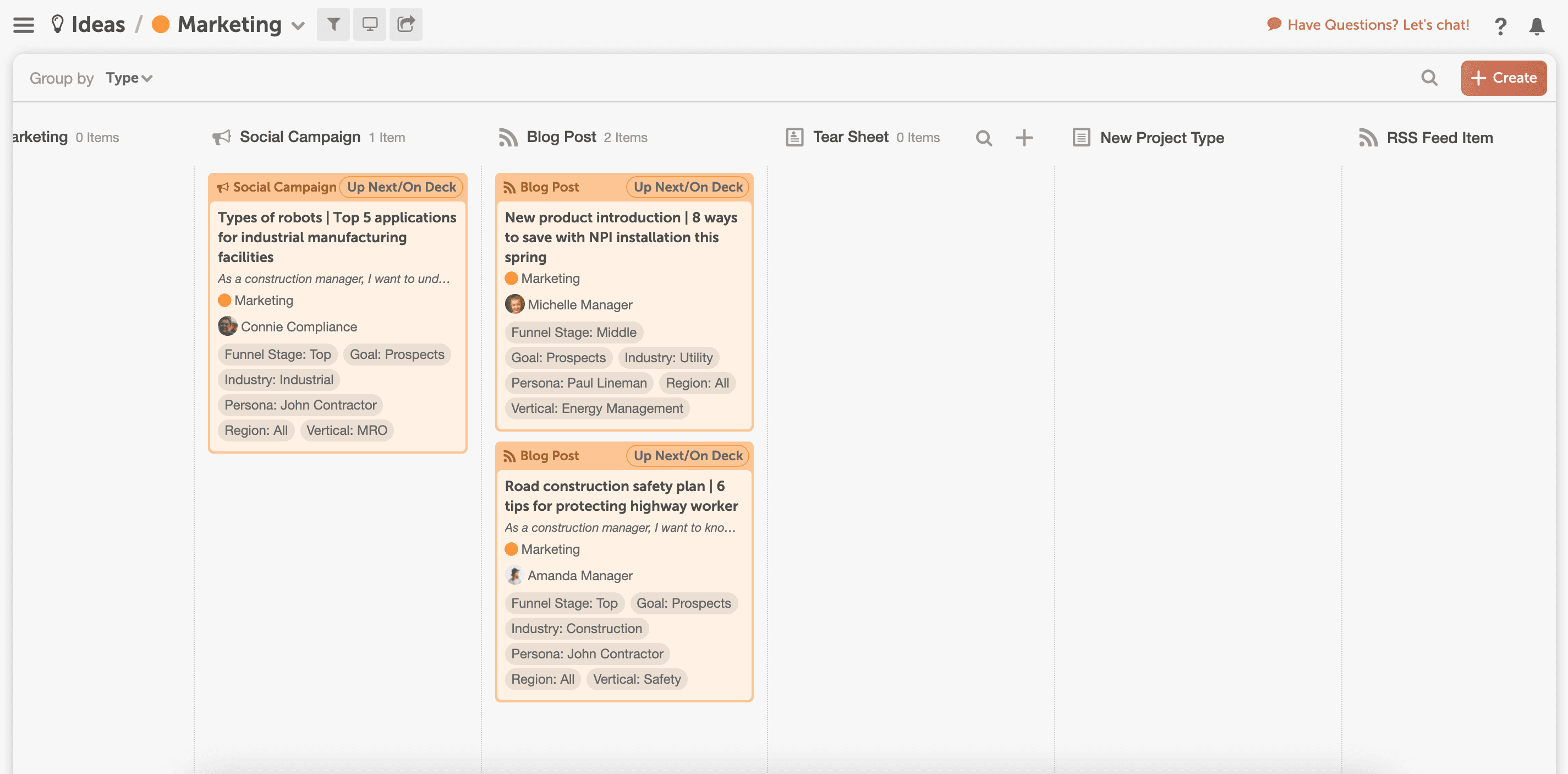
The bottom line? Don’t be afraid to move them around if it isn’t working out.
That’s the great thing about having your own content calendar: you can do whatever you need with it in order to make your ideas fit in with the rest of your calendar.
Establish a Publishing Schedule
Now, you’ll need to determine how often to publish content. This includes determining your posting frequency, as well as days and times.
When you’re starting out, it’s helpful to start small. Even if you only schedule one blog post, that’s one more thing you’ve gotten organized than before. You can worry about scaling your content production later.
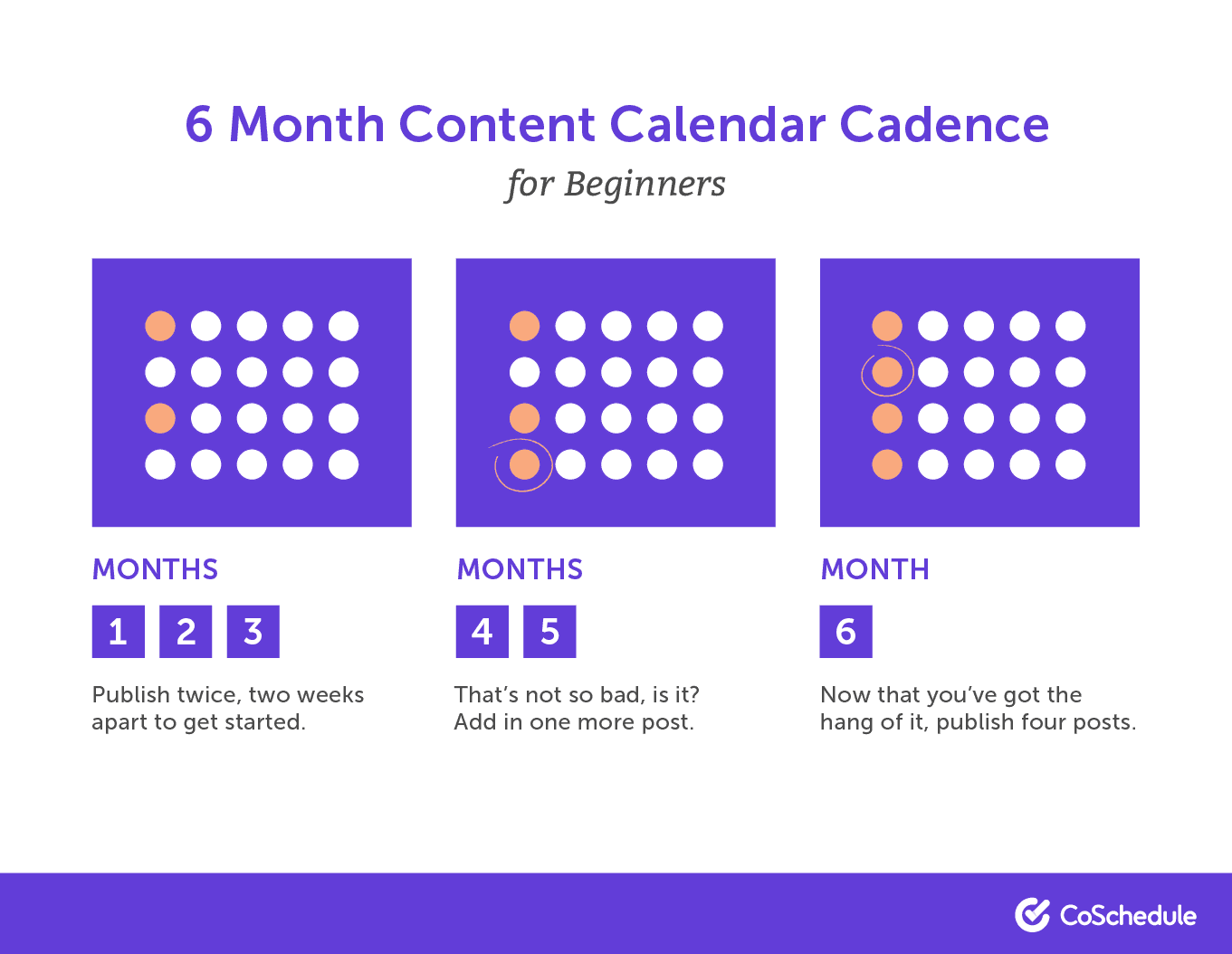
In order to ensure your content gets seen, follow guidelines on the best time to publish a blog post. Research pits that at:
- Monday at 11am EST to get the most traffic.
- Saturday at 9am EST to get the most comments.
- Mondays and Thursdays at 7am EST to get the most inbound links.
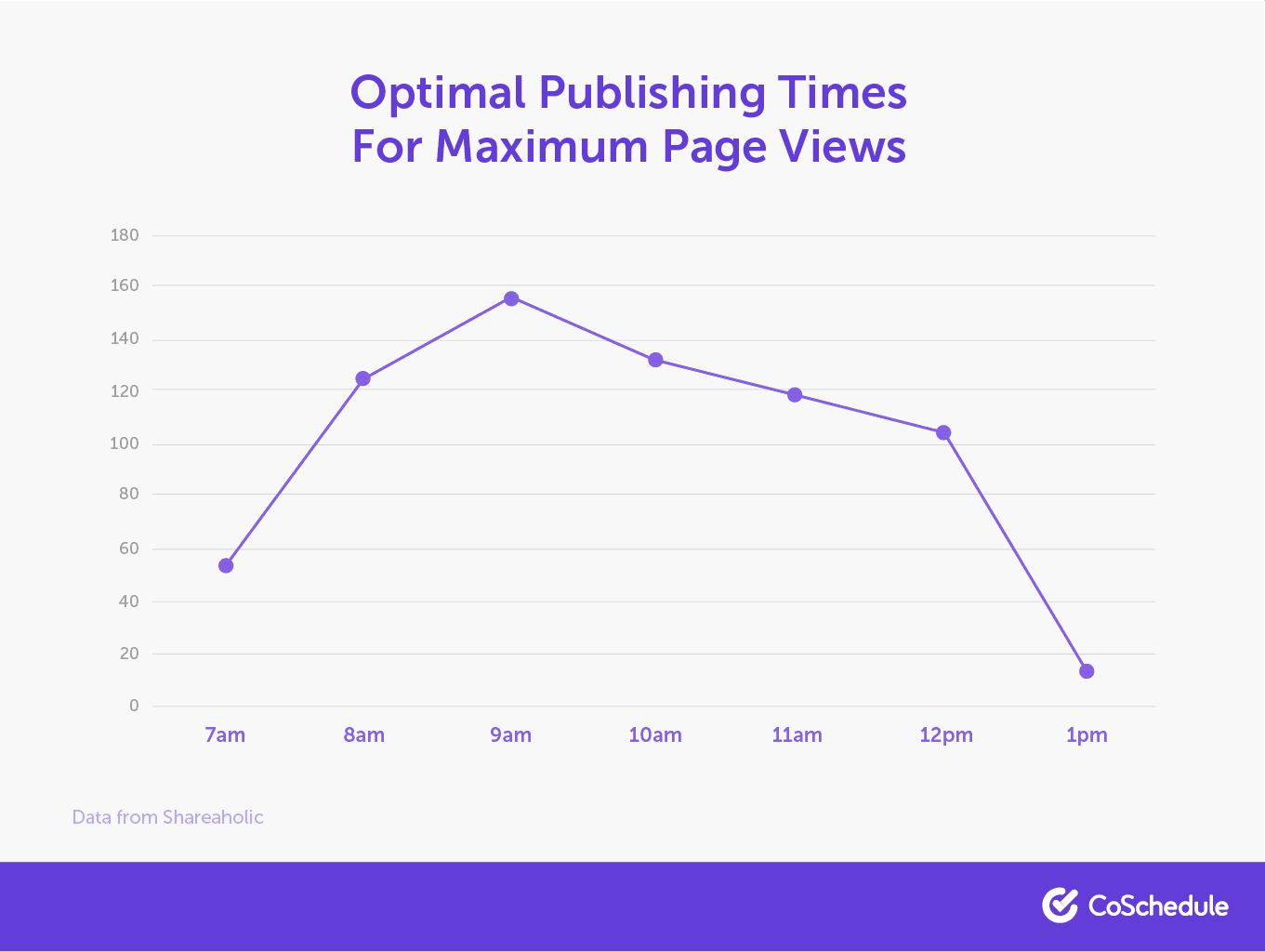
Assuming you’ll be promoting your content via email as well, it’s important to keep timing and frequency of sending emails in mind. The last thing you want to do is annoy your prospects with too many emails in their inbox.
You also don’t want to be sending them emails when they’re most busy because then they’ll completely miss your reach.
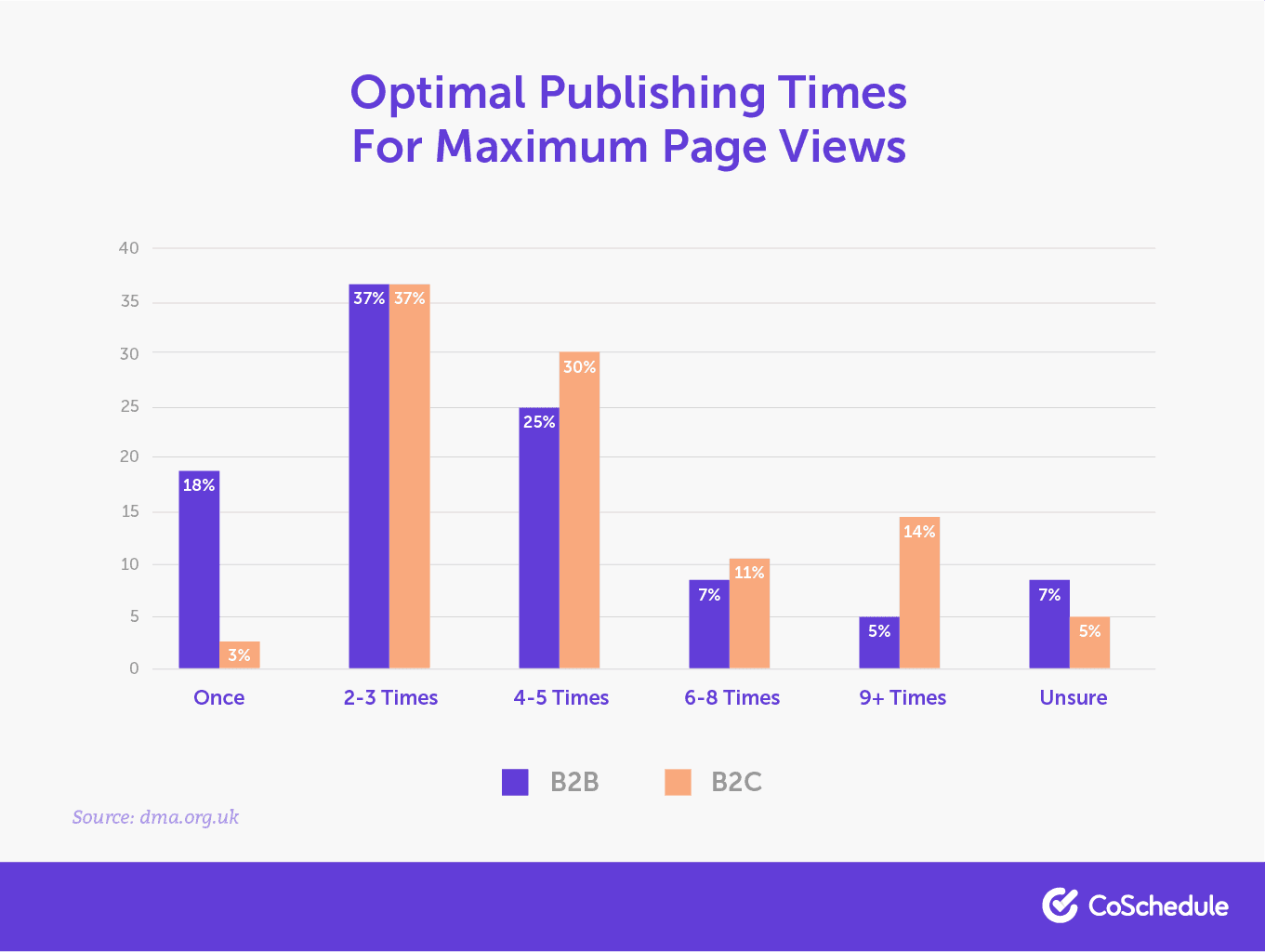
(Don’t forget to include an option for your lists to opt out of emails, in case the subscription isn’t working for them.)
In order to get a better understanding of your promotions, list out the different platforms in which you plan to post your content, then figure out how often you want to publish on each platform.
Work those into your content calendar based on your original posting schedule.
Set Clear Deadlines
If you’re working on a team, it’s helpful to have one person be in charge of project managing the content calendar.
Of course, you can have team members add their own stuff, and make them responsible for hitting their deadlines. However, having one person keeping an eye on everything can be helpful.
Your calendar owner should be responsible for determining:
- Who will manage the calendar
- Who will have access to the calendar
- Which projects go on the calendar
- How often the calendar will be updated
It would be helpful to your whole team if you scheduled monthly or quarterly content planning meetings, so everyone stays in the loop about your calendar.
The most important task for your content calendar manager? Setting and meeting deadlines.
For each piece of content on the calendar, add an estimated time for completion. Give yourself some breathing room just in case things don’t go to plan. (Like a staff member being off sick for two days in the middle of a campaign planning sprint.)
Calendar owners should also be giving team members a nudge if their projects are nearing a deadline and ensuring the timing and planning of content and marketing initiatives makes sense.
Your calendar should be your single version of truth. If it’s on your calendar, it should be an actual project that you’re really going to create, and it should be tied to.
Finally, owners need to throw a red flag if something looks off. If something doesn’t look right, it’s this person’s job to call it out. This person can be anyone on your team who is suited for this task.
Advanced Content Calendar Tips
You’ve got your content calendar set-up and you’re using it regularly.
Want to get more from your new publishing schedule? Here are three advanced tips to make sure your team is using it to its full potential.
Get Team Buy-In to Change Process
What good is a new content calendar tool if your team isn’t actually using it?
It’s not just content marketers that should be using the calendar tool to prepare, plan, and publish new content. Your entire marketing department should rely on the calendar to prioritize the campaigns they’re working on.
The only downside? People are reluctant to change.
Get team buy-in for your new content calendar by explaining its benefits:
- It’ll improve their productivity since they can see what needs to be done and when.
- They don’t need to quiz (and frustrate) co-workers to get content production updates.
- Automations mean they can eliminate most repetitive tasks.
Remember: when pitching a new software for your team to use, explain the positive impact it’ll have for them and their role. Time savings, productivity gains, and impressive marketing results are all big wins.
Plan Content Creation Processes and Workflows
Speaking of getting buy-in, it’ll be easier for you to get your marketing team to use the new content calendar if you make it easy for them to do so.
So, create workflows for your standard content creation processes.
Let’s use blog posts as an example. You likely have these 7-step process that marketers go through each time they’re scheduling a new blog post for the company site:
- Research and outline
- Write draft
- Design visual content
- Approve content
- Format in WordPress
- Final review and publish
- Schedule promotion posts
Use your content calendar to dish out those subtasks to your team.
With CoSchedule’s Task Templates, for example, you can explain the workflow for each type of content you’re creating—be that blog posts, podcast episodes, or webinars.
Whenever you’re creating a new piece of content, duplicate the Task Template. Add which team member is responsible for the subtasks, and when each one needs to be done by.
The end result? Consistent content that gets completed on-time, every time.
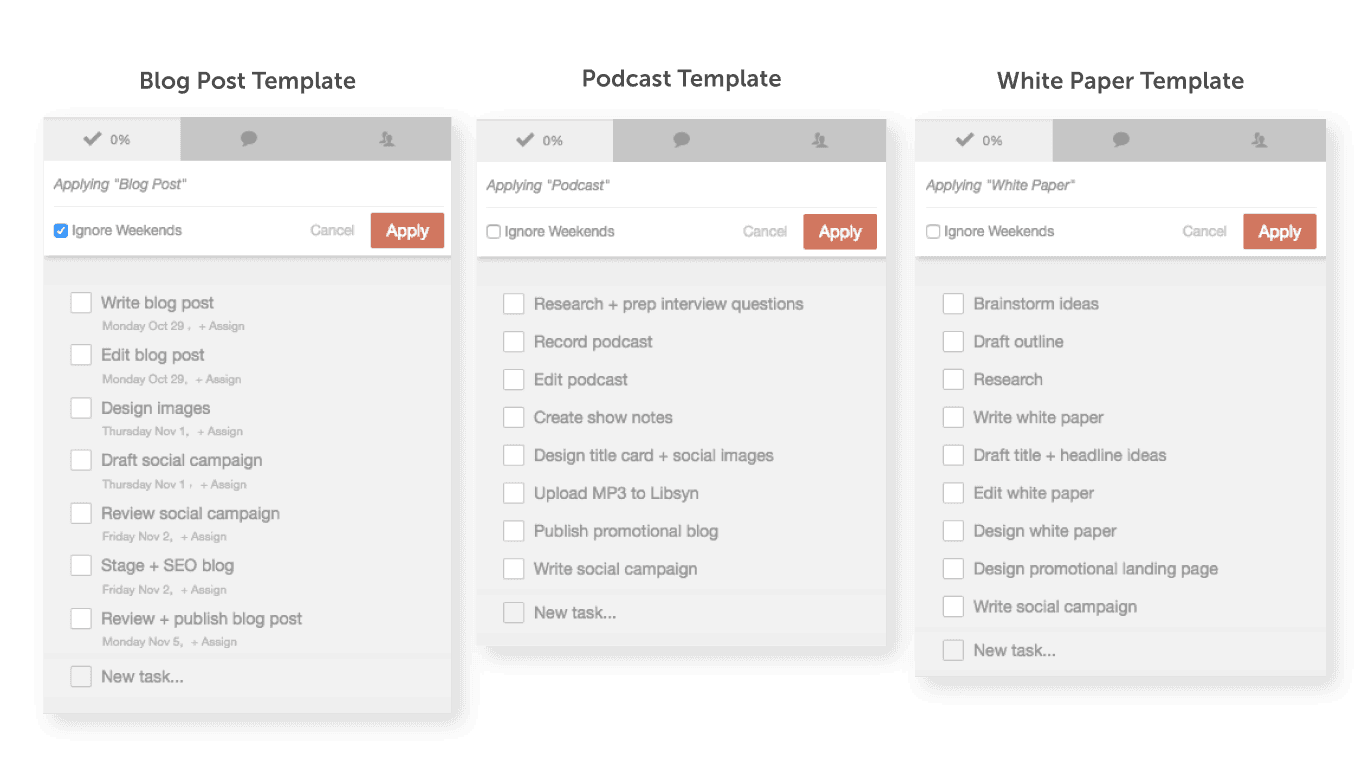
Measure Productivity
No good marketer sets and forgets a new strategy—content calendars included.
The goal of a content calendar is to increase team productivity and create high-quality content. So, make time to measure whether the new system is having an impact on your team’s productivity and overall content marketing strategy.
With CoSchedule’s Team Performance report, you can use metrics like:
- Task completion rate
- Number of overdue tasks
- Workflow completion by team member
…to see how your team’s productivity and performance has changed since using the new content calendar.
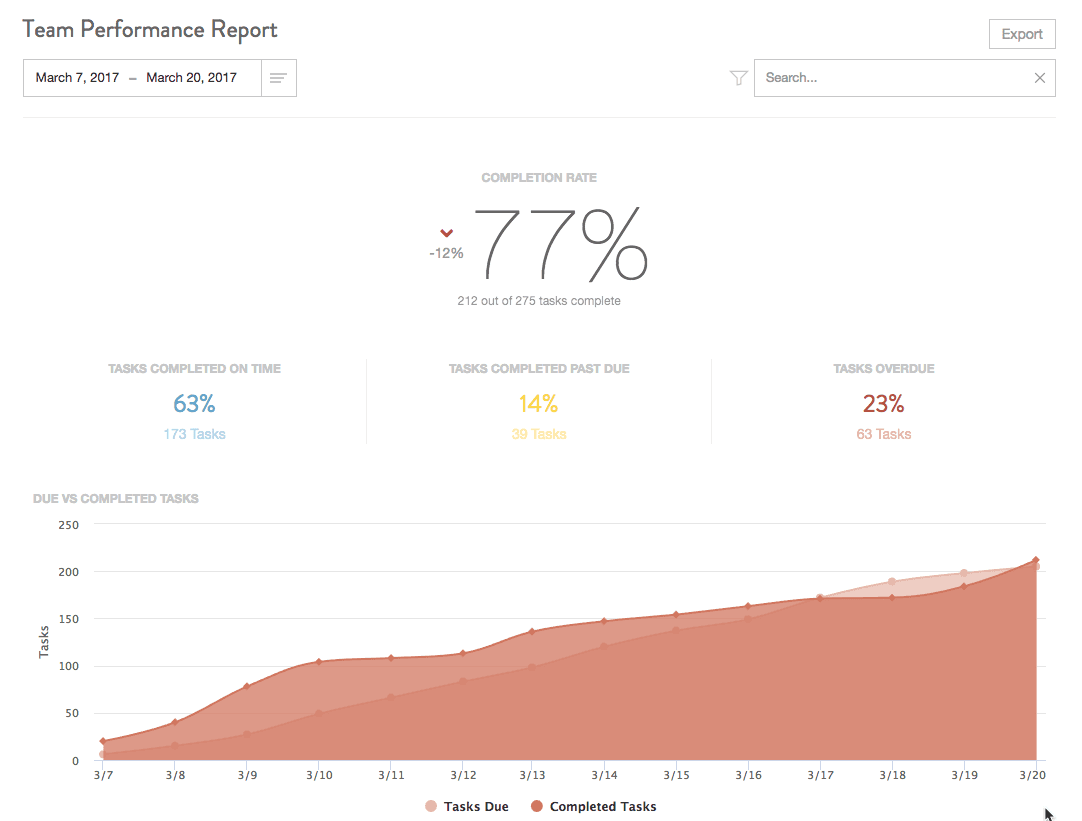
These insights aren’t just nice-to-know snippets of data. Use them to finetune your content calendar.
For example: if you see that the majority of research tasks on your content calendar are completed late, talk with your team to find out why. It could be because the estimated completion time for that task is unrealistic.
So, allow your team extra time to do that without impacting future subtasks in the workflow.
Content Calendar Example
Curious to know what a real content calendar looks like?
Here’s a look at the first month of CoSchedule’s content calendar from 2013. We started out small, publishing just a handful of blog posts each month:
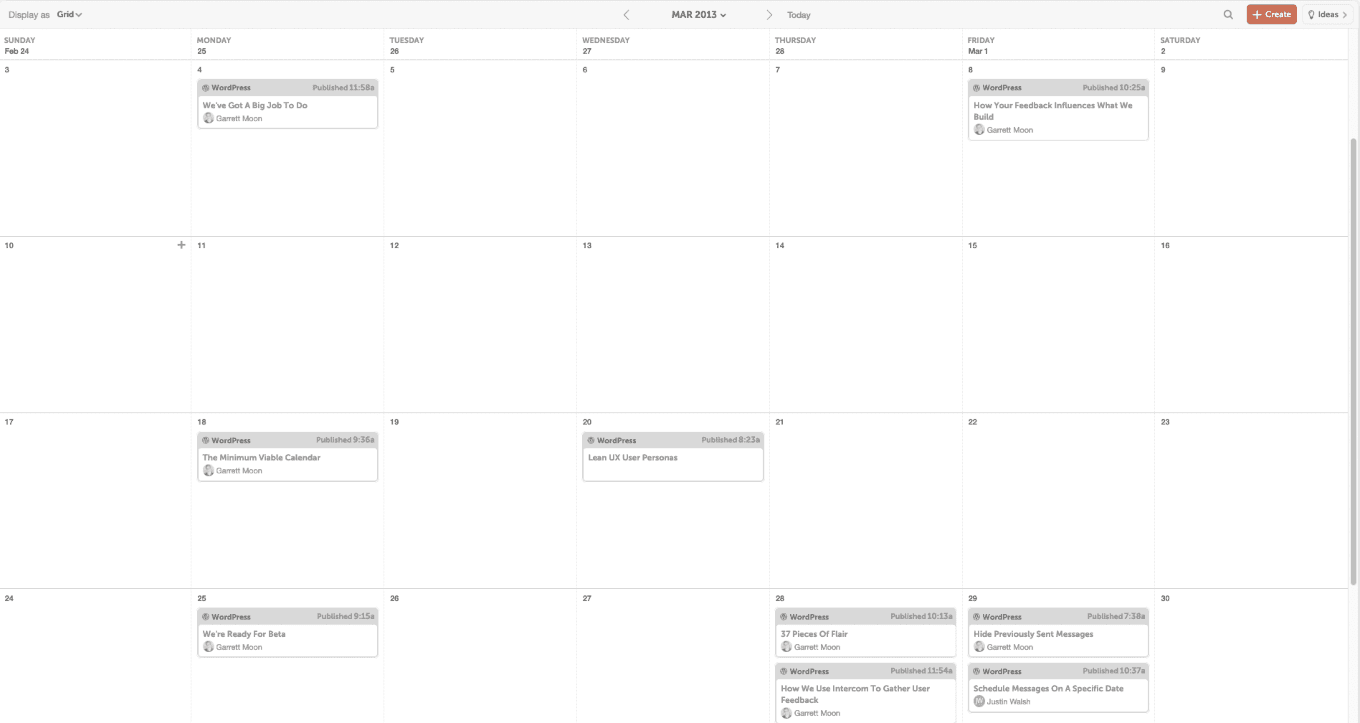
Fast forward to June 2021 and here’s what CoSchedule’s weekly calendar looks like.
Over time, we scaled our content production—going from a new blog post inconsistently when we got the chance, to a variety of different content types (including social media, website copy, and creative briefs) thoughtfully planned out in advance.
Now, we’re producing more work in one week than we used to in a month. It’s all made possible through a content calendar that plans every piece of content we’re working on.
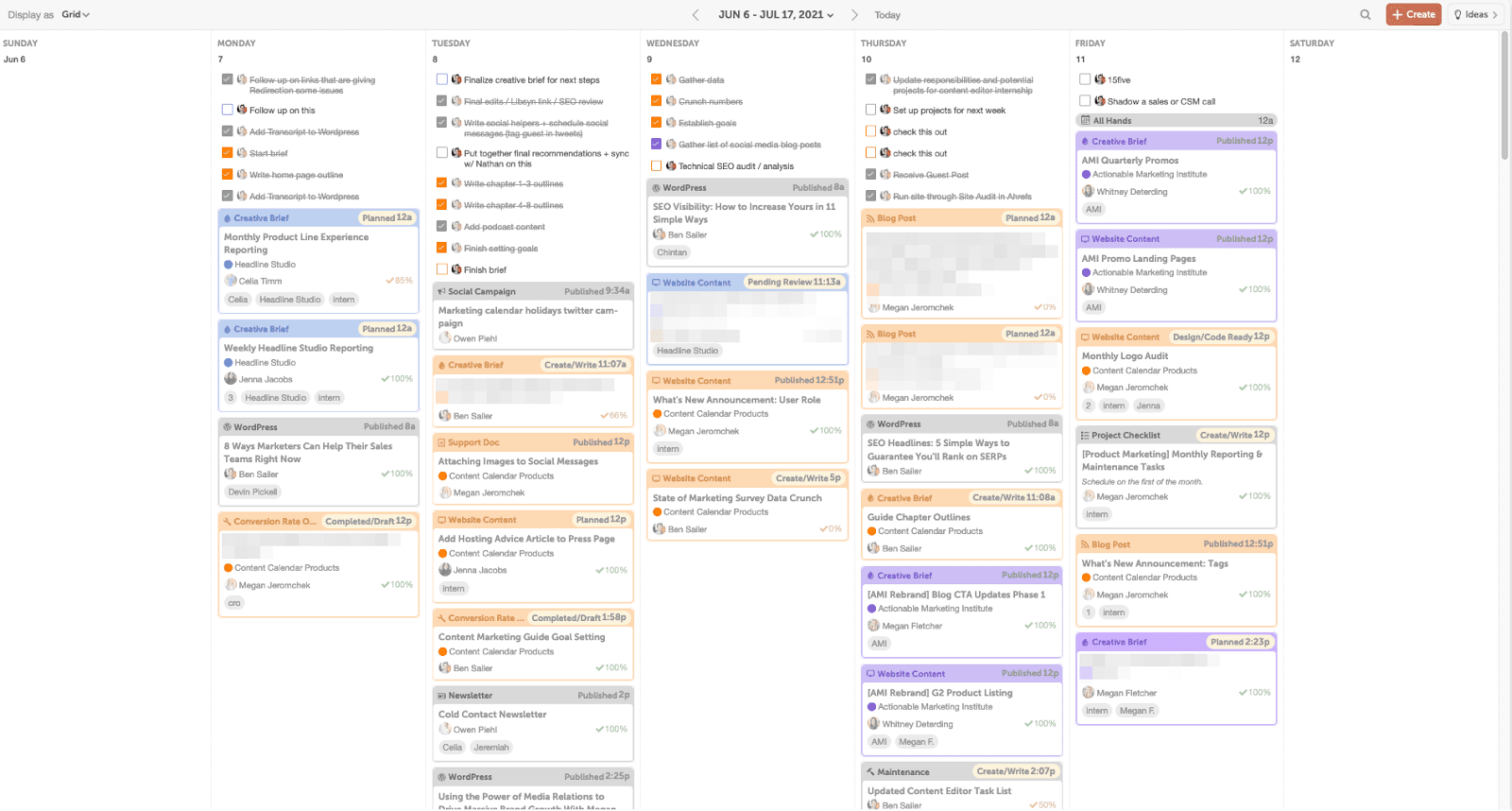
A Content Calendar Case Study
Still not sold on the value of having a content calendar?
For an example of what a clear publishing schedule can do for your content, take a look at what ON24 was able to accomplish in a short period of time once they started using CoSchedule.
They managed to quadruple their blog output from 24 to a whopping 112 posts per year.
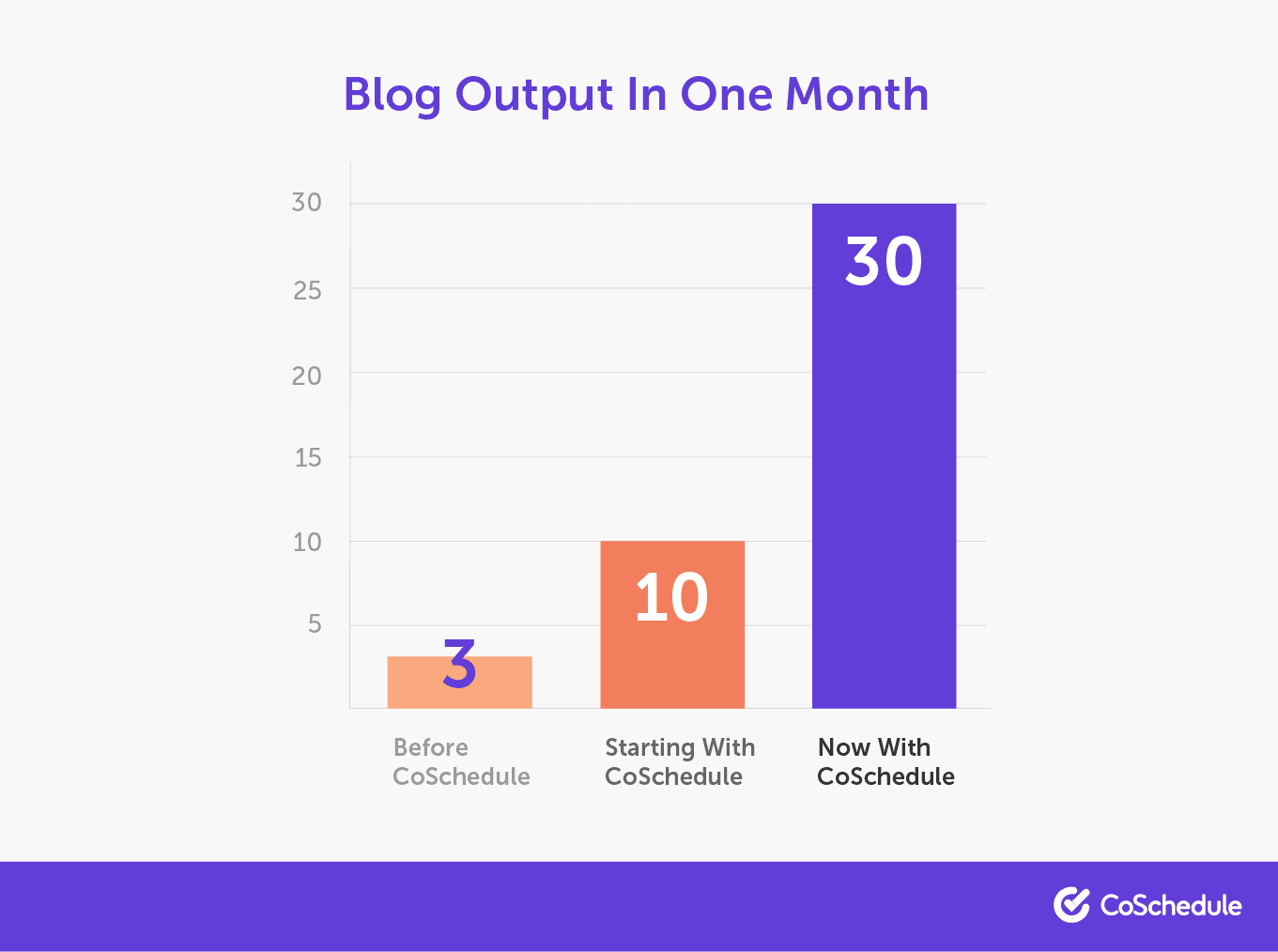
Alongside their significant increase in publishing volume, ON24 was also able to:
- Give their entire marketing team full visibility into all of the brand’s content across each marketing platform. Removing that ambiguity improved content collaboration.
- Hit deadlines more consistently. That means less stress, more efficiency, and better work.
- Increased blog traffic by 98% over a 2-year period, and specifically increased organic traffic by 1,412%. Those are incredible numbers, and numbers don’t lie.

Ready to Create Your Own Content Calendar for 2021?
We’ve discussed what makes up a content calendar, why they’re helpful to you and your projects, how to use them in the most effective way, and provided some awesome examples of businesses that put all of these ideas into practice.
With all of these great reasons to use a collaborative content calendar and examples to back them up, it’s time to start putting your own content calendar together.
It’s a boatload of work that is well worth the extra effort, and your team will thank you for it.
Your future self will be thanking you, too.
The post The Best Content Calendar Template to Organize Your Entire Year in 2021 appeared first on CoSchedule Blog.


![Read more about the article [Best of Season] AMP 080: How To Use Conversion Psychology To Get Better Results With Joanna Wiebe From Copyhackers](https://www.dimaservices.agency/wp-content/uploads/2022/02/274_Joanna-Wiebe-Podcast-Graphics_header-300x128.png)
![Read more about the article The State of B2B Digital Marketing: 5 Findings That Will Influence Your Next Steps [2021 Research]](https://www.dimaservices.agency/wp-content/uploads/2021/07/The-State-of-B2B-Digital-Marketing-5-Findings-That-Will-Influence-Your-Next-Steps--300x150.png)
![Read more about the article How AI Will Make Content Marketing Better (And Why a Robot Probably Won’t Steal Your Job) With Jeff Coyle From MarketMuse [AMP 226]](https://www.dimaservices.agency/wp-content/uploads/2021/03/226_Jeff-Podcast-Graphics_header-300x128.png)